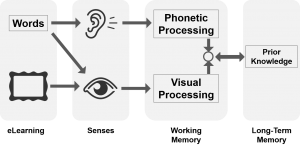
Research into our cognitive architecture has led to the development of Cognitive Load Theory (CLT) and related guidelines which, when applied, results in more efficient learning.
It’s widely accepted that our memory system consists of three components – a sensory memory that receives information from our surroundings, a working memory to process this information and also to retrieve information from our long-term memory.
- Working memory – As the name suggests, our working memory (formerly known as short-term memory) actively processes information. Information enters the working memory from either our sensory memory (our senses) due to our interaction with the world around us or it’s retrieved from our long-term memory. The ability of our working memory to hold information is very limited so it can easily be overloaded.
- Long-term Memory – Whilst working memory is responsible for the active processing of information, the long-term memory is the storage area of our memory system. Information is stored in the long-term memory in knowledge structures known as schemas or mental models. The number of schemas held in long-term memory is what differentiates experts from novices therefore, the focus of any instruction should be the formation and construction of schemas in the long-term memory.
- Cognitive Load Theory – The study of the human memory system and its components has provided extensive evidence about how humans process and store new and existing pieces of information. This knowledge is essential when it comes to designing instructional activities and to account for the processing and storage capabilities of the human memory system.
CLT is “a universal set of instructional principles and evidence-based guidelines that offer the most efficient methods to design and deliver instructional environments in ways that best utilise the limited capacity of working memory” (Clark et. al, 2006, p.342).
Some other points to note about CLT
1. It’s universal so applies to all types of content, delivery methods and people.
2. Offers principles and instructional guidelines.
3. Evidence based, there’s been lots of studies and experiments to test the theory.
4. Applying the findings leads to more efficient learning.
5. Leverages our learning process.
Three Types of Cognitive Load
- Intrinsic – which is the mental work imposed by the complexity of the task or content. Another factor to consider with intrinsic load is element interactivity which is the number of elements that interact with each other.
- Extraneous – which imposes mental effort by including items that are irrelevant to the learning goal and wastes cognitive resources. A lot of eLearning content could be improved if extraneous load was removed.
- Germane – which allows cognitive resources to be put towards learning.
Principles based on CLT
A number of principles have been developed based on CLT. Examples of these principles include:
- Worked example effect – giving novice learners worked solutions of unfamiliar problems to study.
- Split-attention effect – reducing the need to integrate multiple sources of information in order for it to be understood.
- Modality effect – presenting information via both the visual and auditory channels. See our other blog post here.
- Redundancy effect – not presenting the same information via both the visual and auditory channels.
Applying these principles to instructional design will facilitate improved learning outcomes because they incorporate the findings of research into the functioning of the human memory system.
Manage Cognitive Load in eLearning
When thinking about eLearning, our cognitive architecture looks like this:

So, let’s look at some things you can do to manage cognitive load in eLearning and help the learning process. Often, it’s about reducing extraneous cognitive load.
- Use the visual and auditory channels as this helps to spread the cognitive load. However, presenting audio and identical on-screen text results in redundant information being processed by the learner. Audio should be used to describe what’s happening on screen to be most effective. Exceptions to this are people are not native speakers of the language and for accessibility.
- When using text and images, text should be placed near the corresponding parts of the image. This will reduce split attention.
- Avoid using decorative images. The image/diagram used should be directly related to the material being presented and not be there to ‘jazz up the screen’.
- Less is more:
- Focus on essential information, write concisely.
- Eliminate extraneous visuals, text and audio – get rid of ‘nice to know’ information.
- Reduce unnecessary words and modes.
External Memory Supports
You can reduce working memory load by providing external memory supports, more commonly known as performance aids or performance supports. Performance aids are beneficial when time is limited to build schemas into long-term memory. They can be used before and after more formal training methods but aren’t suitable if something needs to be completed quickly and accurately. Performance aids are most effective when they predominately use visuals.
Summary
All of the research into our memory systems and cognitive load is extremely useful as it provides evidence-based insights into how people process information. In turn, it allows designers to create activities based around the processing limitations that people have. As a result, by incorporating these factors into our designs, we can improve the overall learning experience.
Find out more about reducing cognitive load theory in eLearning here.
